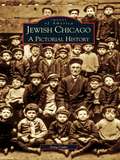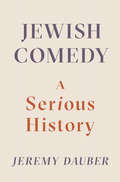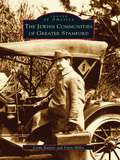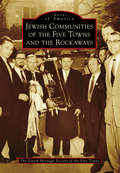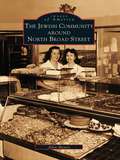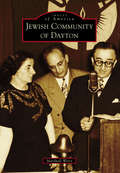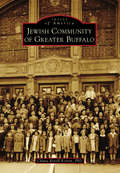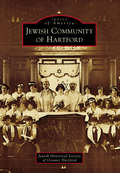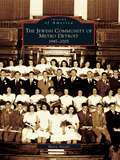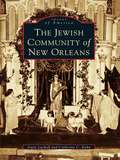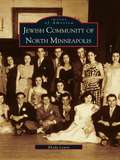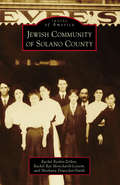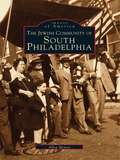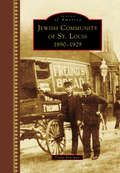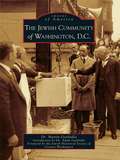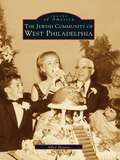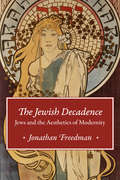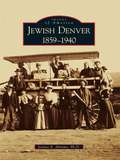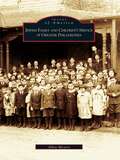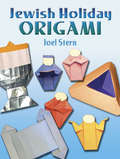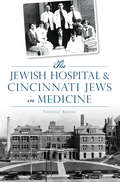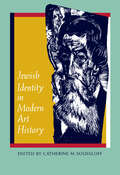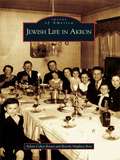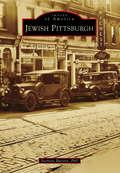- Table View
- List View
Jewish Chicago: A Pictorial History (Images of America)
by Irving CutlerFor many years Chicago had the third largest Jewishpopulation of any city in the world. Through the medium of historic photographs, this book captures the remarkable evolution of the Jewish people of Chicago, from their immigrant beginnings in the 1840s to their present-day communities. It is a story of the cultural, religious, economic, and everyday life of Chicago's Jews. These pages bring to life the people, events, neighborhoods, and institutions that helped shape and transform today's Jewish community. The photos and maps, culled from the author's and other collections, paint a vivid and informative picture of Chicago Jewry. In addition to recalling the early immigrant German and later Eastern European Jews, this book delves into Jewish neighborhoods including the West Side, South Side, North Side, suburban communities, and Maxwell Street, a neighborhood which produced such prominent Jews as musician Benny Goodman, U.S. Supreme Court Justice Arthur Goldberg, Admiral Hyman Rickover, community organizer Saul Alinsky, and CBS founder William Paley. Chicago Jews have also made contributions to the city and the nation in the arts,commerce and industry, government service, entertainment, and labor, including seven Nobel prize winners. The images show Jews as peddlers and sweatshop workers as well as successful business entrepreneurs and professionals.
Jewish Comedy: A Serious History
by Jeremy DauberFinalist for the National Jewish Book Award A rich account of Jewish humor: its nature, its development, and its vital role throughout history. In a major work of scholarship both erudite and very funny, Columbia professor Jeremy Dauber traces the origins of Jewish comedy and its development from biblical times to the age of Twitter. Organizing the product of Jews’ comic imagination over continents and centuries into what he calls the seven strands of Jewish comedy—including the satirical, the witty, and the vulgar—he traces the ways Jewish comedy has mirrored, and sometimes even shaped, the course of Jewish history. Persecution, cultural assimilation, religious revival, diaspora, Zionism—all of these, and more, were grist for the Jewish comic mill; and Dauber’s book takes readers on the tour of the funny side of some very serious business. (And vice versa.) In a work of dazzling scope, readers will encounter comic masterpieces here that range from Talmudic rabbi jokes to medieval skits, Yiddish satires and Borscht Belt routines to scenes from Seinfeld and Broad City, and the book of Esther to Adam Sandler’s “Hanukkah Song.” Dauber also explores the rise and fall of popular comic archetypes such as the Jewish mother, the Jewish American Princess, and the schlemiel, the schlimazel, and the schmuck, and the classic works of such masters of Jewish comedy as Sholem Aleichem, Isaac Babel, Franz Kafka, the Marx Brothers, Woody Allen, Joan Rivers, Philip Roth, Mel Brooks, Sarah Silverman, Jon Stewart, and Larry David, among many others. Jewish comedy, as Dauber writes, is serious business. And precisely what it is, how it developed, and how its various strands weave together and in conversation with the Jewish story: that’s Jewish Comedy.
Jewish Communities of Greater Stamford, The (Images of America)
by Linda Baulsir Irwin MillerThe Jewish Communities of Greater Stamford presents a broad historical view of the Jewish people of Stamford, Darien, Greenwich, and New Canaan, Connecticut, and Pound Ridge, New York. The book goes back to the era just prior to the American Revolution, when lone Jewish families settled among the Connecticut Yankees to engage in trade, manufacturing, and commerce.The earliest settlers-such as Nehemiah Marks, who was living and doing business in Stamford as early as 1720-opened stores and other commercial enterprises. By the mid-1800s, city dwellers began coming to the region for summer vacations. After 1880, settlers arrived via the peddlers' routes and, after accumulating a little capital, stayed to open shops and establish themselves socially and politically. The greatest influx came in the 1890s and early 1900s, when many Jews arrived from the Pale of Settlements, eastern and central Europe, Lithuania, Poland, Russia, Romania, and the Austro-Hungarian Empire.
Jewish Communities of the Five Towns and the Rockaways (Images of America)
by The Jewish Heritage Society of the Five TownsThe Five Towns--comprising the villages of Cedarhurst and Lawrence and the communities of Woodmere, Hewlett, and Inwood--is an area nestled on the South Shore of Long Island next to the easternmost part of Queens, known as Far Rockaway. Originally popular as a Jewish summer vacation spot near the Atlantic Ocean, the Five Towns and the Far Rockaway area grew to become a thriving, year-round Jewish metropolis, with thousands of families and scores of synagogues and Jewish educational institutions. A center for shopping and kosher restaurants, the Five Towns area has become one of the most popular locations for young, married Jewish couples. Jewish influence has expanded greatly in local government and education. The rich history of the early years of Jewish growth and development in the Five Towns and Rockaways lends a deeper understanding of this phenomenal change of demographics and influence that has occurred over the last few decades.
Jewish Community Around North Broad Street, The (Images of America)
by Allen MeyersThe cradle of Jewish life in Philadelphia began with the establishment of the first synagogue, Mikveh Israel, in 1740. With the influx of many German Jews in the 1840s, the community expanded above Spring Garden Street into the Northern Liberties neighborhood. Urban settlement of Philadelphia's Jewish population during the last quarter of the nineteenth century shifted to North Broad Street when the economy improved for the city's residents after the Civil War. North Broad Street soon boasted two elegantly designed synagogues and the newly relocated Jewish Hospital from West Philadelphia.The Jewish Community around North Broad Street weaves the tale of the Jewish community in this part of Philadelphia through a collection of rare and stunning images. The construction of the North Broad Street subway in the 1920s and the row house Jewish community known as Logan are parts of this story. The development of business districts led to a more cohesive north and northwest Jewish community that allowed for satellite Jewish enclaves to flourish, complete with their own synagogues, bakeries, kosher meat markets, and hundreds of other shops that served the general population. In the 1950s, new neighborhoods, such as Mount Airy and West Oak Lane, alleviated an acute housing shortage at a time when 110,000 Jews lived in north-central and northwest Philadelphia.
Jewish Community of Dayton (Images of America)
by Marshall WeissSince the arrival of approximately a dozen German-Jewish immigrants in the 1840s, the Jewish community of Dayton has actively contributed to the betterment and welfare of the "Gem City." Jewish Community of Dayton recalls forgotten stories of Arthur Welsh, the first Jewish airplane pilot; orphan turned social reformer Rabbi David Lefkowitz; Golda Meir's impassioned 1948 visit on behalf of the new Jewish state; and opera star Jan Peerce giving the final performance of his career with the acclaimed Beth Abraham Youth Chorale. This book illustrates how Dayton's Jews have responded and adapted to challenges ranging from the Great Flood of 1913 to resettlement of immigrants throughout the 20th century, from sacrifices for the state of Israel to activism in the civil rights era.
Jewish Community of Greater Buffalo (Images of America)
by Chana Revell KotzinJewish community life in Buffalo began in 1847 with the founding of Temple Beth El. A dominantly German Jewish community transformed in the 1880s as Eastern European Jews settled around William Street. Intense religious and commercial vibrancy emerged with new synagogues alongside Jewish grocery stores, kosher butchers, clothiers, and more. From this east side milieu, lyricist Jack Yellen ("Happy Days are Here Again") and composer Harold Arlen ("Over the Rainbow") emerged as part of a new generation shaping local and national American life. On the west side, Temple Beth Zion, the Jewish Federation, Jewish Community Center, Jewish Family Service, and Rosa Coplon Jewish Old Folks Home built institutions on and around Delaware Avenue. Jewish areas in Humboldt, North Buffalo, Kenmore, Amherst, Getzville, and Williamsville developed over time. Camp Lakeland continued earlier traditions of summer camping. Throughout the 20th century, Jewish Buffalonians made their marks as entrepreneurs, distinguished lawyers, award-winning writers, and Nobel Prize scientists, among other careers. The Jewish Community of Greater Buffalo showcases Buffalo and Niagara Falls Jewry over the last two centuries.
Jewish Community of Hartford (Images of America)
by Jewish Historical Society of Greater HartfordHartford’s Jewish presence dates back to the mid-1600s. The earliest permanent settlers were German Jews, who purchased the first building for use as a synagogue in 1856. With increasing immigration from Eastern Europe, the population soon expanded. Jewish-owned businesses became part of Hartford’s economic life, and numerous civic and social welfare organizations were established. In 1945, many philanthropic groups consolidated to create the Jewish Federation of Greater Hartford, which later relocated to West Hartford as the community shifted to the surrounding suburbs. Among the Hartford area’s most accomplished sons and daughters are entertainer Sophie Tucker, producer Norman Lear, comedienne Totie Fields, artist Sol LeWitt, and significant Zionist leaders, such as Samuel Hoffenberg and Abraham Goldstein. The Jewish Community of Hartford highlights some of the people and institutions that have helped to shape this remarkable community.
Jewish Community of Metro Detroit: 1945-2005, The (Images of America)
by Barry StiefelAfter the end of World War II, Americans across the United States began a mass migration from the urban centers to suburbia. Entire neighborhoods transplanted themselves. The Jewish Community of Metro Detroit: 1945 -2005 provides a pictorial history of the Detroit Jewish community's transition from the city to the suburbs outside of Detroit. For the Jewish communities, life in the Detroit suburbs has been focused on family within a pluralism that embraces the spectrum of experience from the most religiously devout to the ethnically secular. Holidays, bar and bat mitzvahs, weddings, and funerals have marked the passage of time. Issues of social justice, homeland, and religion have divided and brought people together. The architecture of the structures the Detroit Jewish community has erected, such as Temple Beth El designed by architect Minoru Yamasaki, testifies to the community's presence.
Jewish Community of New Orleans, The (Images of America)
by Irwin Lachoff Catherine C. KahnNew Orleans is not a typical Southern city. The Jews who have settled in New Orleans from 1757 to the present have had a very different experience than others in the South. New Orleans was a wide-open frontier that attracted gamblers, sailors, con artists, planters, and merchants. Most early Jewish immigrants were bachelors who took Catholic wives, if they married at all. The first congregation, Gates of Mercy, was founded in 1827, and by 1860, four congregations represented Sephardic, French and German, and Polish Jewry. The reform movement, the largest denomination today, took hold after the Civil War with the founding of Temple Sinai. Small as it is in proportion to the population of New Orleans, the Jewish community has made contributions that far exceed their numbers in cultural, educational, and philanthropic gifts to the city.
Jewish Community of North Minneapolis (Images of America)
by Rhoda LewinThe stories of the Jewish community of North Minneapolis are an important part of the rich and diverse mosaic of North Minneapolis history. By 1936, there were more than 16,000 Jew in Minneapolis, and 70 percent of them lived on the North Side. The Jewish Community of North Minneapolis presents an intriguing record of the earliest beginnings of Jewish communities in the city. Through the medium of historic photographs, this book captures the cultural, economic, political, and social history of this community, from the late 1800s to the present day. The Jews in North Minneapolis enjoyed a busy social and cultural life with their landsmanschaften, and shopped together at the kosher butcher shops and fish markets, grocery stores and bakeries, clothing stores, barber shops, restaurants, and other small businesses that had sprung up along Sixth Avenue North and then Plymouth Avenue. Including vintage images and tales of the community-Hebrew schools, synagogues, and social groups-this collection uncovers the challenges and triumphs of the Jewish community.
Jewish Community of Solano County (Images of America)
by Rachel Rae Moncharsh-Lessem Shoshana Deutscher-Nurik Rachel Raskin-ZrihenThis book contains images and stories of some of the Jews who have impacted Solano County. It is not a record of every Jew to pass this way, some of whom may have come intending to shed their Jewish identity by changing their names or converting. Wonderful stories emerged about extraordinary people who made their marks here with few suspecting their Jewish roots, yet they were traceable often because in death they chose to reclaim their heritage. Others came to live as Jews and built an enduring community. The story within these pages travels from the Old World to the edge of Gold Country, where there lives a tenacious, though often invisible, Jewish community.
Jewish Community of South Philadelphia, The: Images Of America (Images of America)
by Allen MeyersFor many Jewish immigrants to America, Philadelphia's row houses provided an instant community of neighbors where they were able to combine the traditions of the Old World with newAmerican ideals. In their flight to a new land and a new life, Jewish immigrants found a place to call home in South Philadelphia. This unprecedented collection of images celebrates the people and places of this community, from their struggles to their triumphs and the family bonds that provided their strength along the way. The Jewish Community of South Philadelphia is a tribute to tradition and pride that will serve as a valuable tool in teaching the history of Jewish immigrants in America. Join Allen Meyers in this exploration of the past that will be enjoyed for generations to come.
Jewish Community of St. Louis: 1890-1929 (Images of America)
by Diane EvermanThe St. Louis Jewish community began in the early 19th century and increased rapidly in the decades surrounding the turn of the century. Jewish immigrants brought skills and determination that helped the community evolve and prosper, but they faced challenges to survive, acculturate, and flourish. Not everyone had easy lives or great wealth, yet most worked to succeed and help others. Jewish endeavors covered all spheres, from small businesses to the Freund Bakery and Stix, Baer and Fuller Department Store to the Lesser-Goldman Cotton Company. Many garment district businesses were owned and run by Jews. Philanthropy and social betterment created the Young Men's Hebrew Association, the Jewish Sanatorium, the Home for Aged & Infirm Israelites, the Jewish Hospital, and many other entities. Members of the Jewish community proudly served in World War I and participated in clubs and organizations, as well as in political, civic, and cultural affairs.
Jewish Community of Washington, D.C., The (Images of America)
by Dr Adam Garfinkle Jewish Historical Society of Greater Washington Dr Martin GarfinkleThe Jewish community of Washington, D.C., located in the political nexus of the United States, has often enjoyed attention from people of every level of influence, including the president of the United States. On May 3, 1925, Calvin Coolidge attended the cornerstone laying ceremony of the Washington Jewish Community Center. Herbert Hoover, as a former president, was vocal in his denunciation of Nazi Germany's treatment of the Jews. His voice garnered the support of many United States senators in 1943, including two from Maryland and one from Virginia. Ronald Reagan sent his personal regards to the Ohev Shalom Talmud Torah Congregation on their 100th anniversary celebration on April 10, 1986.
Jewish Community of West Philadelphia, The: Images Of America (Images of America)
by Allen MeyersThe Jewish community of Philadelphia west of the Schuylkill River is a composite of seven distinct neighborhoods surrounding West Philadelphia proper. These include Fortieth and Girard, Parkside, Wynnefield, Overbrook Park, Wynnefield Heights, Southwest Philly, and Island Road.A gathering of seventy-five thousand Jewish people in West Philadelphia during the twentieth century qualified the area known as "a city within a city" as a second settlement area. Excellent public transportation included the famed Market Street Elevated. The West Philadelphia Jews flourished and supported dozens of synagogues and bakeries, and more than one hundred kosher butcher shops at the neighborhood's height from the 1930s through the 1950s. Newly arrived immigrants embraced traditional Jewish values, which led them to encourage their offspring to acquire a secondary education in their own neighborhoods as a way of achieving assimilation into the community at large. The Jewish Community of West Philadelphia portrays Jewish life throughout West Philadelphia in the mid-twentieth century. The book captures rare, nearly forgotten images with photographs gleaned from the community at large.
The Jewish Decadence: Jews and the Aesthetics of Modernity
by Jonathan FreedmanAs Jewish writers, artists, and intellectuals made their way into Western European and Anglo-American cultural centers, they encountered a society obsessed with decadence. An avant-garde movement characterized by self-consciously artificial art and literature, philosophic pessimism, and an interest in nonnormative sexualities, decadence was also a smear, whereby Jews were viewed as the source of social and cultural decline. In The Jewish Decadence, Jonathan Freedman argues that Jewish engagement with decadence played a major role in the emergence of modernism and the making of Jewish culture from the 1870s to the present. The first to tell this sweeping story, Freedman demonstrates the centrality of decadence to the aesthetics of modernity and its inextricability from Jewishness. Freedman recounts a series of diverse and surprising episodes that he insists do not belong solely to the past, but instead reveal that the identification of Jewishness with decadence persists today.
Jewish Denver: 1859-1940 (Images of America)
by Jeanne E. AbramsIn 1859, during the Pike's Peak gold rush, at least 12 Jews joined the great migration to Colorado in search of gold and a brighter future. The unpredictability of mining and a growing demand for supplies encouraged many of these Jewish settlers to establish small businesses in Denver and in towns and mining camps across the state. By the early 1870s, Jewish benevolent societies and a congregation were established. Denver's dry, mild climate attracted patients with tuberculosis, and two Jewish sanatoriums were opened in the city around the beginning of the 20th century. Many of the predominantly Eastern European Jews who came in search of better health made Denver their home, thus augmenting the early Jewish population significantly. Today Jewish life flourishes in Colorado, and Jewish citizens continue to play a vital role in its culture and development.
Jewish Family and Children's Service of Greater Philadelphia (Images of America)
by Allen MeyersJewish Family and Children's Service of Greater Philadelphia (JFCS) resulted from the merger of two important human service organizations in 1983: the Association for Jewish Children of Philadelphia and Jewish Family Service of Philadelphia. Helping one in four Jewish households in crisis and in need as well as thousands of others, JFCS plays a primary role in the Greater Philadelphia community. The earliest predecessor of JFCS, the Jewish Foster Home, opened in 1855 with five children in its care. Established through the leadership of Rebecca Gratz, the foremost American Jewish female leader of her day, it was the nation's first Jewish orphanage and heralded a record of compassion, skill, and innovation in community services. Today, JFCS reaches out to more than 41,000 individuals and families each year with a wide array of programs from adoption to senior services. Jewish Family and Children's Service of Greater Philadelphia is the first illustrated history of this organization. With numerous historic photographs, including images from the 150th anniversary celebration in 2005, this book touches on all aspects of the organization's history: services, programs, staff, and fund-raising.
Jewish Holiday Origami
by Joel SternObserve Purim with a handmade megillah or a hamentash. Create models of the four sons for Passover, and fashion a scroll for Simchat Torah. This clearly diagrammed manual provides simple directions for creating these and fifteeen other origami projects to help observe Jewish holidays, both festive and solemn.Clearly detailed illustrations and captions explain all the steps for an entire year's worth of holiday projects--from Chanukah dreidels and a menorah with candles to Passover pyramids and an image of the Red Sea parting. Additional projects for weekly observances include sabbath candles and kiddush cup.Great for synagogues, schools and homes, this easy-to-follow guide offers beginning paperfolders a unique, fun-filled way to celebrate Jewish culture
Jewish Hospital & Cincinnati Jews in Medicine, The (American Heritage)
by Frederic KromeCincinnati Jewish Hospital has remained a beacon of service to the city for more than a century and a half. Although it always accepted patients regardless of their heritage or faith, the institution maintains its Jewish identity. Founded in 1850, the Hospital weathered depressions and wars while reflecting changes that occurred within the Jewish community and the city. Cincinnati's Jewish health professionals pioneered medical education, new treatments for polio and the introduction of new psychological treatments for children. Author Frederic Krome explores the fascinating history of the Cincinnati Jewish Hospital and the many contributions Cincinnati Jews made to the field of medicine.
Jewish Identity in Modern Art History
by Catherine M. SoussloffIn the first comprehensive study of Jewish identity and its meaning for the history of art, eleven influential scholars illuminate the formative role of Jews as subjects of art historical discourse. At the same time, these essays introduce to art history an understanding of the place of cultural identity in the production of scholarship.Contributors explore the meaning of Jewishness to writers and artists alike through such topics as exile, iconoclasm, and anti-Semitism. Included are essays on Anselm Kiefer and Theodor Adorno; the effects of the Enlightenment; the rise of the nation-state; Nazi policies on art history; the criticism of Meyer Schapiro, Clement Greenberg, and Aby Warburg; the art of Judy Chicago, Eleanor Antin, and Morris Gottlieb; and Jewish patronage of German Expressionist art.Offering a new approach to the history of art in which the cultural identities of the makers and interpreters play a constitutive role, this collection begins an important and overdue dialogue that will have a significant impact on the fields of art history, Jewish studies, and cultural studies.
Jewish Life in Akron (Images of America)
by Beverly Magilavy Rose Arlene Cohen RossenIn the mid-1800s, many Jewish families joined the western expansion and emigrated from Germany to Akron, a canal town that also had an inviting countryside. They sought economic security and religious freedom--a new start in a new town. But it was not an easy life. They organized their Jewish community into cultural and religious groups, and by the 20th century, their efforts attracted Central and Eastern European Jews with differing lifestyles. In 1929, the Akron Jewish Center opened and provided a place for all of the diverse Jewish groups in Akron to gather. It also played an enormous role in raising awareness of the richness of Jewish life in the Akron community. Jewish Life in Akron celebrates 150 years of Jewish culture, family, business, and organizational life through vintage images, many never before published, and supporting history.
Jewish Mad Men: Advertising and the Design of the American Jewish Experience
by Professor Kerri P. SteinbergIt is easy to dismiss advertising as simply the background chatter of modern life, often annoying, sometimes hilarious, and ultimately meaningless. But Kerri P. Steinberg argues that a careful study of the history of advertising can reveal a wealth of insight into a culture. In Jewish Mad Men, Steinberg looks specifically at how advertising helped shape the evolution of American Jewish life and culture over the past one hundred years. Drawing on case studies of famous advertising campaigns--from Levy's Rye Bread ("You don't have to be Jewish to love Levy's") to Hebrew National hot dogs ("We answer to a higher authority")--Steinberg examines advertisements from the late nineteenth-century in New York, the center of advertising in the United States, to trace changes in Jewish life there and across the entire country. She looks at ads aimed at the immigrant population, at suburbanites in midcentury, and at hipster and post-denominational Jews today. In addition to discussing campaigns for everything from Manischewitz wine to matzoh, Jewish Mad Men also portrays the legendary Jewish figures in advertising--like Albert Lasker and Bill Bernbach--and lesser known "Mad Men" like Joseph Jacobs, whose pioneering agency created the brilliantly successful Maxwell House Coffee Haggadah. Throughout, Steinberg uses the lens of advertising to illuminate the Jewish trajectory from outsider to insider, and the related arc of immigration, acculturation, upward mobility, and suburbanization.Anchored in the illustrations, photographs, jingles, and taglines of advertising, Jewish Mad Men features a dozen color advertisements and many black-and-white images. Lively and insightful, this book offers a unique look at both advertising and Jewish life in the United States.
Jewish Pittsburgh (Images of America)
by Barbara BurstinBy the mid-19th century, Jews from German lands began settling in Pittsburgh, later to be followed by Jews from the Russian and Austro-Hungarian Empires and Romania. They founded businesses and organizations such as Giant Eagle, Kaufmann's Department Store, Montefiore Hospital, the Pittsburgh Playhouse, the Civic Light Opera, and the Pittsburgh Pirates. Sophie Masloff became the first woman and the first Jew to serve as mayor, and civic reformer and lawyer A. Leo Weil, philanthropist Leon Falk Jr., and social justice crusader Florence Reizenstein all had schools named after them. From Allegheny City and "the Hill" to Squirrel Hill and the East End, the Jewish population preserved its distinct core community and contributed to its adopted city in multiple ways. Today, it numbers more than 40,000, and their story is one of grit, determination, risk taking, hard knocks, and no small measure of success.
